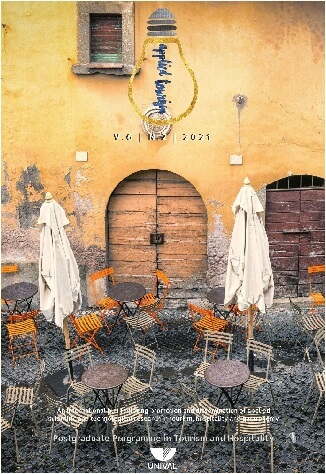

This report focuses on different forms of tourist attraction of the Sami indigenous people in the city Tromsø/Norway, such as identity marks and maintenance of traditions. The general objective is to analyse signs as symbolic elements of the Sami people, showing their potential for indigenous ethnic tourism. We conducted a survey of tourist attractions, and verified how this service is provided for tourists. This study uses as methodological and theorical perspective that is exploratory in nature, according to Husserl’s phenomenology (2001), with strategies of ethnography (MATTOS, 2011) and Peirce’s semiotics (2011). This research took place in Tromsø/Norway city, which is located 350 kilometers north of the Arctic Circle and is home to the Sami people. The techniques of interlocution with those involved resulted in field annotations, and the techniques of participant observation, open-ended interview, pictures and audio recordings with ten participants were also used. Besides the interviews, documents were studied, such as Convention 169 of the International Labor Organization (ILO) and the Sami legislation. It was observed, as a result of this research, that the city of Tromsø in Norway has evident tourist potential through the culture of the Sami people. The tourist attractions are varied, such as watching the Northern Lights, reindeer herding, and listening to stories of ancestry closely connected to nature, in a dialogic relationship between cultural tradition and science. It was also found that these tourist attractions are carried out responsibly, with sustainability in mind.




BAHL, M. Dimensão cultural do turismo étnico. In: A. P. Netto; M. G. dos R. Ansarah, (Eds.). Segmentação do mercado turístico (121-140). Barueri: Manole, 2016.
CRESWELL, J. Projeto de Pesquisa métodos qualitativos, quantitativos e mistos. Tradução Magda Lopes. 3ªed. Porto Alegre: Artmed, 2010.
DARTIGUES, André. O que é a fenomenologia? Tradução de Maria José J. G. de Almeida. 32 ed. Editora Moraes Ltda. São Paulo, 1999.
DORSCH, Laura Lou Peres. A Objectificação da Cultura Sámi: Adaptabilidade no Tempo e Reconhecimento da Identidade no Norte da Sápmi Norueguesa. Dissertação de Mestrado. Instituto Universitário de Lisboa. Departamento de Antropologia. Lisboa. 2017 Edições 70.2010.
HUSSERL, E. A ideia da fenomenologia. Lisboa: Edições 70, 2001.
LANGER, Johnni. Símbolos religiosos dos Vikings: Guia iconográfico. História, imagem e narrativas, v. 11, 2010, p. 1-28.
LEHTOLA, Veli-Pekka. (s.d.). Sami on the stages and in the zoos of Europe in Onthestages, Giellagas institute at the University of Oulu. Uleåborg, Finland. p.324-353 (s/d).
LIGIÉRO, Zeca. Estudos das performances brasileiras. Rio de Janeiro: Garamond, 2011.
MATTOS, CLG. A abordagem etnográfica na investigação científica. In MATTOS, CLG.; CASTRO, PA. (Orgs). Etnografia e educação: conceitos e usos. Campina Grande: EDUEPB, 2011.
MERLEAU-PONTY, Maurice. Signos. São Paulo: Martins Fontes, 1991.
OLIVEIRA. Ricardo Wagner Menezes de Oliveira. Feras Petrificadas: O simbolismo religioso dos animais na Era Viking. Dissertação. Mestrado em Ciências das Religiões. Programa de Pós-Graduação em Ciências das Religiões. João Pessoa: 2016.
ORGANIZAÇÃO INTERNACIONAL DO TRABALHO. OIT 169. Available at: http://www.planalto.gov.br/ccivil_03/_ato2004-2006/2004/decreto/d5051.htm. Accessed on: May 7, 2020.
PEIRCE, C. S. Semiótica e filosofia. Introdução de Octanny Silveira de Mota e Leonidas Hegenberg. São Paulo: Cultrix, 2010.
RICOEUR, P. Teoria da interpretação: o discurso e o excesso de significação. Lisbon: Tradução Magda Lopes. 3ª ed. Porto Alegre: Armede, 2010.
TSIOUVALAS, Apostolos. Não Desperte a Rávga de Repparfjord: contação de Histórias de Sámi para Discutir a Disposição de Resíduos de Mineração de Nussir ASA. 2020. Dissertação de Mestrado. UiT Norges arktiske universitet. Available at: https://hdl.handle.net/10037/18683. Accessed on Sept. 23, 2020.
VISITTROMSØ. Portal VisitTromso: Imagens. Available at: https://www.visittromso.no/. Accessed on: May 2, 2020.




Copyright (c) 2024 Joelma Monteiro de Carvalho, Luciano Torres Tricárico

Este trabalho está licenciado sob uma licença Creative Commons Attribution-ShareAlike 4.0 International License.






Uma plataforma internacional com a finalidade de promover e disseminar a pesquisa científica e tecnológica aplicada em turismo, hospitalidade e gastronomia.

